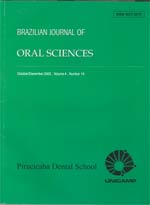
|
Brazilian Journal of Oral Sciences
Piracicaba Dental School - UNICAMP
EISSN:
Vol. 14, No. 4, 2015, pp. 323-329
|
 Bioline Code: os15058
Bioline Code: os15058
Full paper language: English
Document type: Research Article
Document available free of charge
|
|
|
Brazilian Journal of Oral Sciences, Vol. 14, No. 4, 2015, pp. 323-329
| en |
Influence of implant-abutment angulations and crown material on stress distribution on central incisor: a 3D FEA
El-Anwar, Mohamed I.; Al-Azrag, Khairy E.; Ghazy, Mohamed H. & Dawood, Lamia E.
Abstract
Aim: To investigate the effect of implant-abutment angulation and crown material on stress distribution
of central incisors. Finite element method was used to simulate the clinical situation of a maxillary right
central incisor restored by two different implant-abutment angulations, 15° and 25°, using two
different crown materials (IPS E-Max CAD and zirconia).
Methods: Two 3D finite element models
were specially prepared for this research simulating the abutment angulations. Commercial
engineering CAD/CAM package was used to model crown, implant abutment complex and bone
(cortical and spongy) in 3D. Linear static analysis was performed by applying a 178 N oblique load.
The obtained results were compared with former experimental results.
Results: Implant Von Mises
stress level was negligibly changed with increasing abutment angulation. The abutment with higher
angulation is mechanically weaker and expected to fail at lower loading in comparison with the
steeper one. Similarly, screw used with abutment angulation of 25° will fail at lower (about one-third)
load value the failure load of similar screw used with abutment angulated by 15°.
Conclusions:
Bone (cortical and spongy) is insensitive to crown material. Increasing abutment angulation from
15° to 25°, increases stress on cortical bone by about 20% and reduces it by about 12% on
spongy bone. Crown fracture resistance is dramatically reduced by increasing abutment angulation.
Zirconia crown showed better performance than E-Max one.
Keywords
finite element analysis; dental implant-abutment design; incisor; materials
|
| |
© Copyright 2015 - Brazilian Journal of Oral Sciences
Alternative site location: http://www.fop.unicamp.br/brjorals
|
|
